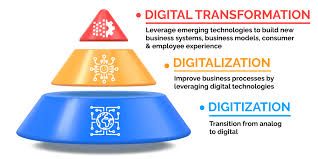
Digital Transformation vs Digitalization vs Digitization: Differences Explained
While related, digitization, digitalization, and digital transformation represent distinct stages of technological integration within a business. The process typically moves from converting information to digital formats (digitization), to using that digital information to improve workflows (digitalization), and finally to a fundamental strategic shift of the entire business (digital transformation).
Digitization (Converting analog to digital)
Digitization is the foundational step of converting analog data into a digital format. It makes information accessible by computers but does not change the underlying business process itself.
- Action: Taking analog information and converting it into binary digits (0s and 1s).
- Scope: Task-specific and focused on the data or information itself.
- Example: Scanning a paper document to create a digital PDF file. A physical photo is converted into a digital file.
Digitalization (Improving processes)
Digitalization is the process of using digital technologies and digitized data to improve existing business operations and workflows. It moves beyond simple conversion to enable new efficiencies and is often an incremental improvement.
- Action: Using digitized data to automate processes and streamline workflows.
- Scope: Focused on a specific business process or department.
- Example: Implementing an Electronic Health Records (HER) system in a hospital to manage, access, and use digitized patient notes more efficiently. This makes the process better, but the fundamental practice of record-keeping remains.
Digital transformation (Strategic evolution)
Digital transformation is a comprehensive, strategic change that integrates digital technology into all areas of a business, fundamentally altering its operations, culture, and value proposition. It rethinks the entire business model to leverage digital opportunities.
- Action: Revolutionizing business models, creating new products or services, and changing an organization’s culture to be more agile and data-driven.
- Scope: Enterprise-wide initiative that impacts the entire organization.
- Example: Netflix’s evolution from a DVD-by-mail service to a global streaming giant, using data analytics and AI to transform its business model and redefine how consumers access entertainment.
